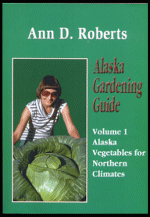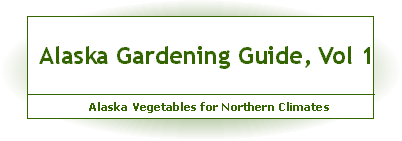 |
 |
Guide, Vol 1 ____________________ |
ISBN # 1-888125-54-3
- $29.95, second printing |
Sowing Success in Southcentral Alaska Part 2 of 3
This is part two of a three part series on gardening in Alaska, and more specifically, Southcentral Alaska. It covers knowing your soil, raised beds, and row covers. For a more comprehensive treatment of the subjects mentioned, please see Alaska Gardening Guide, Vol. 1.
©2005,Ann D. Roberts
Know Your Soil
Alaska's major soil for gardening purposes is a very fine-textured glacial silt, low in organic matter, with poor soil structure. It tends to be thicker in valleys and on lower slopes.
Less common, clay is potentially the richest of all soils, once the food “locked up" in it is released, and it will need the least watering. Sand added to cold soils will lighten and warm them. Most kinds of greens are recommended for clay.
Sandy soils are easy to work, warm up earlier in the spring, and are aerated and well drained, needing the most watering. Root crops do well in light soil.
Much of Southcentral’s soil is a thin layer of silt over sandy gravel, requiring constant “rock picking." Many gardeners in Anchorage solve the problem by building growing boxes filled with good screened topsoil. Growing boxes, or “raised beds” are highly recommended for warming soil.
Raise Beds to Warm and Dry
Soil in raised beds is warmer, and the technique may delay fall frosts which tend to settle in low-lying areas. Raised beds have the added advantage of lifting plants up out of the water during the rainy season, making them nearly essential for Southeast Alaska.
Till under raised rows when fall comes, or make them permanent with containing boards. If contained, provide drainage, allowing room for larger root systems that may result from warmer growing conditions. Narrow mounds drain and dry out too quickly. The most effective mounds are about 12 inches high and 18 to 24 inches across the top. Multiple rows (or better yet, wide-row broadcast or staggered plantings) use the space most efficiently.
Arrange mounds north to south, with slanting east/west sides at right angles to the sun's rays during the warmest part of the day. Soil absorbs the most heat from rays hitting directly; slanting sides compensate for the lower angle of northern sunrays. If, however, the raised rows are on a slope, orient them perpendicular to the slope, to avoid problems with erosion; i.e., on a southern slope, run rows east to west.
Clear Plastic
Planting through clear plastic film was pioneered in Alaska by Dr. Donald H. Dinkel and recommended by the University of Alaska. Soil temperatures as high as 120° (at 4 inches deep) are possible beneath clear polyethylene mulch - NOT black plastic film. Black plastic controls weeds better than clear, but soil will be heated directly only when the black polyethylene is in direct, total contact; any little lump will foil it.
Light passes through clear polyethylene into the ground, being absorbed by the dark soil and transformed into heat. The air beneath is heated, and condensation forms on the underside. This water is sun-heated, then drips on the soil. Thus the soil is being heated three ways: condensate, air under the plastic, and direct heating of the soil.
Soil remains warmer during our short summer night as the ground slowly gives up its heat, hindered by the plastic. Of great importance to Southcentral gardeners, the clear film enables the soil to be heated even in the weaker light of a cloudy day or when the soil is not receiving direct rays from the sun (early morning and late evening).
Ann D Roberts is the author of Alaska Gardening Guide Vol 1, covering cold weather gardening in Alaska, with specific growing tips for vegetables. The book, written and published in Alaska in 2000, is already the “definitive and indispensable reference guide to every Alaskan gardener.” Readers can check out its table of contents at http://AlaskaGardeningGuide.com. Ann is presently working on Vol 2, covering perennials and lawns. This article may be freely reprinted only if done so in its entirety, including this final paragraph.
Copyright 2002-2011, Aurora Webmasters Last updated January 24, 2012 Contact the Author, Ann D. Roberts. a member of the Garden Writers Association
by e-mailing: author*@*alaskagardeningguide.com (delete every *)